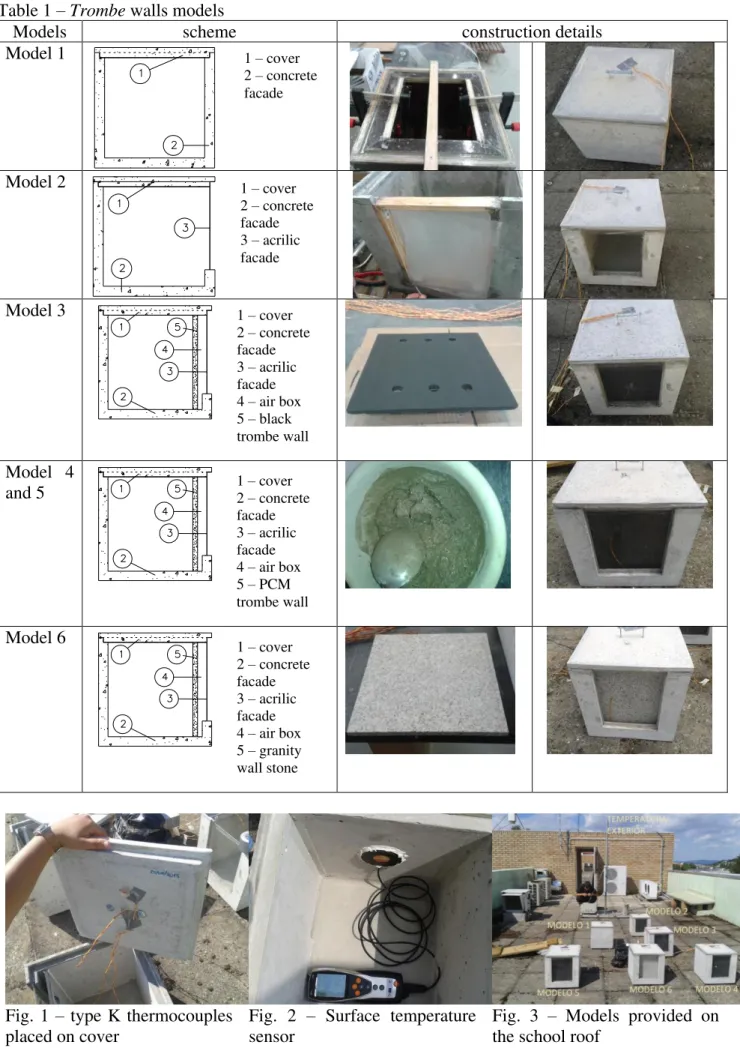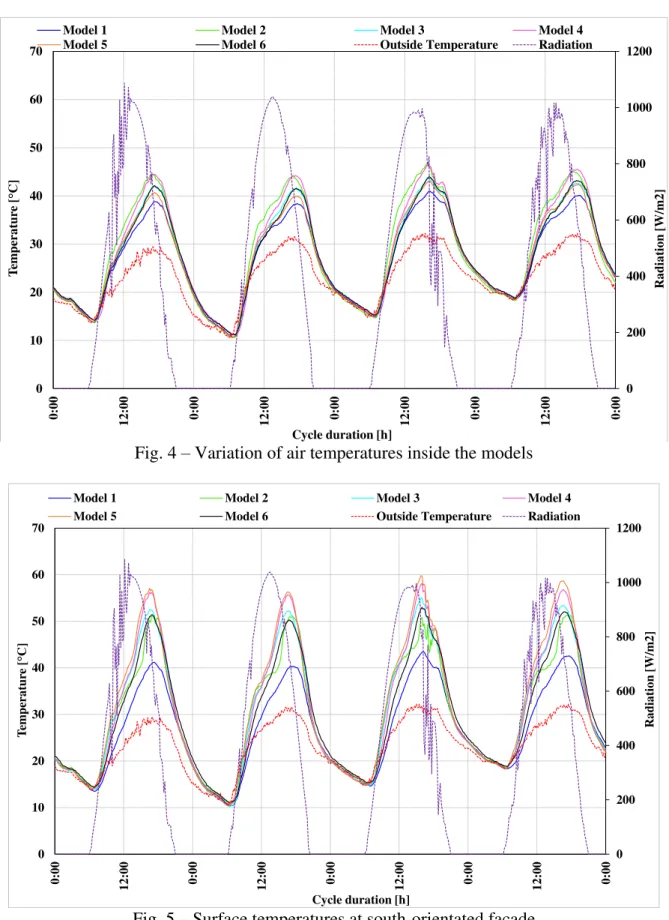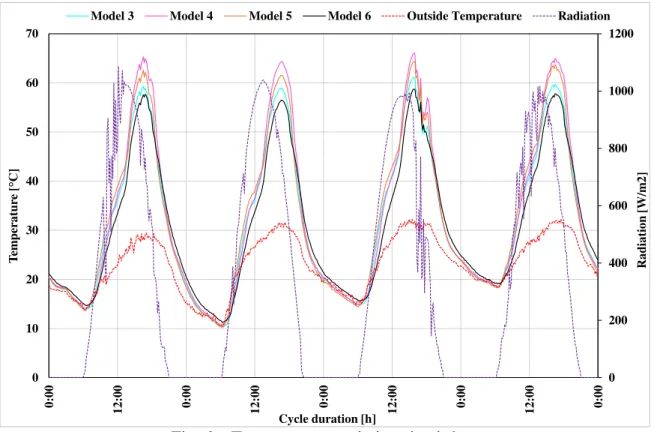Proceedings of the 7th International Conference on
Safety and Durability of Structures
ICOSADOS 2016
May 10 - 12, 2016, UTAD, Portugal
Passive solar system applied in
trombe
walls
Débora Ferreira
1,2,a, Sónia Cerdeira
1,b, Eduarda Luso
1,c, Rafael Gonçalves
1,d,
and Manuel Minhoto
1,3,e1Polytechnic Institute of Bragança (IPB-ESTiG) – Bragança, Portugal
2C-MADE, University of Beira Interior, Portugal; 3C-TAC, University of Minho, Portugal
adebora@ipb.pt, bsoniaaa11@hotmail.com, ceduarda@ipb.pt, drrgman@hotmail,com, eminhoto@ipb.pt
Keywords: PCM, thermal mortar, trombe wall, testing models.
Introduction
A phase-change material (PCM) is a substance with a high heat of fusion, with the capability of melting and solidifying at a certain temperature, and is capable of storing and releasing large (certain) amounts of energy. Heat is absorbed or released when the material changes from solid to liquid and vice versa. Thus, PCMs are classified as latent heat storage (LHS) units.
The PCM may be classified as organic, inorganic and eutectic mixtures. The organic compounds are further divided into non-paraffinic and paraffin, the inorganic compounds can be classified into hydrated salts and metal [1].
The idea to use PCMs for the purpose of storing thermal energy is to make use of the latent heat of a phase change, usually between the solid and the liquid states, for thermal control purposes in construction. Since a phase change involves a large amount of latent energy at small temperature changes, PCMs are used for temperature stabilization and for storing heat with large energy densities in combination with rather small temperature changes in that materials.
The successful usage of PCMs, is by one side a question of a high energy storage density, but by another side hand it is very important to be able to charge and discharge the energy storage with a thermal power, like sun, that is suitable for the desired application [2].
Materials likely to be used for phase change thermal energy storage that have been studied during the last 40 years are hydrated salts, paraffin waxes, fatty acids and eutectics of organic and non-organic compounds. A eutectic mixture is a composition of two or more components that melt congruently forming and crystallizing a mixture of compounds crystals [3].
The PCM’s have countless applications in different areas, initially being used in the textile,
footwear and automotive industry, but can now be used for thermal energy storage in buildings. The use of PCM's is primarily aimed at increasing the thermal comfort of human being, particularly in the construction industry. With their use a decrease of energy consumption is to be expected [4, 5, 6, 7].
can be placed on roofs, walls, ceilings, floors, glazing, ventilation systems, and building materials (bricks, concrete).
The work presented here is related to the study of a passive solar system applied in facades with
trombe wall, which is a construction technology that allows reducing the energy consumption of buildings [8]. In particular, the effect of the incorporation of phase changing materials (PCM's) was assessed using namely a PCM based on paraffin and another one based on octadecane.
This study is primarily based in the execution, experimental analysis, and comparison of results obtained in test models.
For this purpose, an experimental campaign conducted at Bragança Polytechnic Institute was performed, firstly, to evaluate the blending mode of all the constituents of the mortar, the content of PCM to incorporate in the mortar, as well as the involved water quantity. These early studies included the mechanical characterization of the mortar with and without PCM. The obtained data indicate that the best results were achieved with the addition of 30% of PCM in the mortar.
The second part or current work was devoted to the study of six test models built using cement mortar and an appropriate geometry. One of the models served as a reference, another sample model was tested considering that the main facade will simulate a window, while the remaining models were executed as a main facade using the trombe wall building system. Trombe walls were built with four different materials: cement mortar, cement mortar with octadecane, cement mortar with paraffin. All models have been developed with the ability of the wall to be ventilated. All models were monitored and tested in terms of thermal behaviour. Three of the walls testing samples were tested simultaneously under the same conditions, during four days. The differences between the test’s layouts are related to the granite wall colour and the ventilation surrounding the models. During the monitoring of the models it was possible to obtain temperature records and thermal conductivity of the main facade elements in 10 to 10 minutes intervals. Also, a direct comparison between the tested models was established.
Main conclusions of this work are that the incorporation of PCM’s into thermal mortars can bring benefits in terms of thermal comfort, greater efficiency, and sustainability to buildings, as well as improve the efficiency of trombe wall building system.
Experimental program
Six trombe wall models were conducted to study a passive solar system applied in facades with
trombe wall, which is a construction technology that allows reducing the energy consumption of buildings. Model 1: all model are in concrete without trombe wall, just for comparison; Model 2: one of the facades are in acrylic with 2.5 mm thick; Model 3: with trombe wall made in concrete painted with black colour; Model 4: trombe wall were built in concrete with the incorporation of octadecane PCM; Model 5: trombe wall were built in concrete with the incorporation of paraffin; Model 6: trombe wall were in grey granite stone, Table 1, [8]. The models 2 to 6 have one of the facades in acrylic. To analyse the temperatures at different points inside the models were placed on type K thermocouples, Fig. 1.
Thermal conductivity is a specific characteristic of each material, and depends strongly on both the purity and the temperature at which it is found (especially at low temperatures). In general, the conduction of thermal energy in the material increases as the temperature increases. The temperature values of the indoor air and outdoor surface, relative humidity, and thermal conductivity of a given element are obtained by means of the testo 435-2 equipment, a multi-function measuring instrument, used according to ISO_9869-1994 [9], Fig 2.
Table 1 –Trombe walls models
Models scheme construction details
Model 1
Model 2
Model 3
Model 4 and 5
Model 6
Fig. 1 – type K thermocouples placed on cover
Fig. 2 – Surface temperature sensor
Fig. 3 – Models provided on the school roof
1 – cover 2 – concrete facade
1 – cover 2 – concrete facade 3 – acrilic facade
1 – cover 2 – concrete facade 3 – acrilic facade 4 – air box 5 – black trombe wall
1 – cover 2 – concrete facade 3 – acrilic facade 4 – air box 5 – PCM trombe wall
Experimental results
Fig. 4 shows the variation of the interior temperature of the test models, the outside temperature, and the radiation incidence on the models. Fig. 5 shows the temperature change at facade south-orientated, outside temperature, and the radiation incident in the models. Fig. 6 shows the temperature variation of the air-boxes of models with trombe wall, the outside temperature and incident radiation in the models.
0 200 400 600 800 1000 1200 0 10 20 30 40 50 60 70 0 :0 0 12
:00 0:00
1
2
:00 0:00
12
:00 0:00
12
:00 0:00
Ra di a ti o n [W /m 2 ] T em pera tur e [ C]
Cycle duration [h]
Model 1 Model 2 Model 3 Model 4
Model 5 Model 6 Outside Temperature Radiation
Fig. 4 – Variation of air temperatures inside the models
0 200 400 600 800 1000 1200 0 10 20 30 40 50 60 70 0:0 0 1 2 :0 0 0 :0 0 1 2 :0 0 0:0 0 1 2 :0 0 0:0 0 1 2 :0 0 0:0 0 R a di a ti o n [W/ m 2 ] T em pera tur e [ C]
Cycle duration [h]
Model 1 Model 2 Model 3 Model 4
Model 5 Model 6 Outside Temperature Radiation
0 200 400 600 800 1000 1200 0 10 20 30 40 50 60 70 0 :0 0 1 2 :0 0 0 :0 0 1 2 :0 0 0 :0 0 1 2 :0 0 0 :0 0 1 2 :0 0 0 :0 0 R a di a ti o n [W/ m 2 ] T em pera tur e [ C]
Cycle duration [h]
Model 3 Model 4 Model 5 Model 6 Outside Temperature Radiation
Fig. 6 – Temperatures variations in air box
Analysing the temperatures inside the models (Fig. 4) it was found that the trombe wall with 1.5 [cm] thick mortar PCM has a behaviour very close to the trombe wall with 2 [cm] thick granite. During the day, the PCM wall heats least and during the night cooling similarly to the wall of granite stone.
In the south-orientated facade with (Fig. 5) one obtains de higher values on the models, as expected. From the analysis of the air temperatures in air box during the day (Fig. 6), it was found that granite and mortar with paraffin heats less than the other surfaces due to its properties, while granite remains longer hot overnight.
Conclusions
The experimental research presented in this work aimed to observe the behaviour of PCM incorporated into the mortar applied to the building system trombe wall, when subjected to typical temperature cycles of heating season.
The use of PCM brings advantages in terms of thermal comfort, economically and socially. Brings more efficiency and sustainability to the buildings.
The construction system is more efficient if the trombe wall has a dark colour and has ventilation. A trombe wall with 1.5 [cm] thick mortar with 30% PCM can work the same way with the same wall 2 [cm] thick granite stone.
In terms of thermal conductivity, a granite wall is better than the wall mortar with 30% PCM, which in turn is better that the wall of cement mortar.
References
[1] N. T. D. F. d. Silva, “Incorporação de Materiais de mudança de fase em materiais de
construção,” Tese de mestrado em Engenharia Civil/Materiais, reabilitação e sustentabilidade na construção, Universidade do Minho, Escola de engenharia, Abril de 2009.
[2] A. Heinz, W. Streicher, “Application of phase change materials and pcm-slurries for thermal
[3] Farid, M. M., Khudhair, A. M., Razack, S. A. K., & Al-Hallaj, S. (2004). A review on phase change energy storage: materials and applications. Energy conversion and management, 45(9), 1597-1615.
[4] P. J. S. Tristão, “Encapsulação de Materiais de Mudança de Fase (PCM) para Aplicações no
Armazenamento de Energia,” Relatório Final de Projeto apresentado na Escola Superior de
Tecnologia e Gestão de Bragança, Novembro de 2014.
[5] D. S. Oliveira, “Identificação do tipo e quantidade de PCM adequado ao clima Português,” Tese de Mestrado em Engenharia Civil, Universidade do Minho, Escola de Engenharia, Outubro de 2012.
[6] A. Sá, “Comportamento térmico de edifícios em Portugal usando materiais de mudança de
fase,” Dissertação submetida para obtenção do grau de doutor , Faculdade de Engenharia da Universidade do Porto, Julho, 2012.
[7] A. C. Martins, “Contribuição da parede de trombe na redução dos consumos energéticos dos
edifícios,” Dissertação apresentada na Universidade de Trás-os-Montes e Alto Douro para a obtenção do grau de mestre em Engenharia Civil, Escola de Ciências e Tecnologias, Departamento de Engenharia Civil, Universidade de Trás-os-Montes e Alto Douro, 2009/2010.
[8] S. A. A. Cerdeira, “Estudo de um sistema solar passivo com incorporação de PCM´S”, Dissertação apresentada no Instituto Politécnico de Bragança para a obtenção do grau de mestre em Engenharia Civil, 2014/2015.


